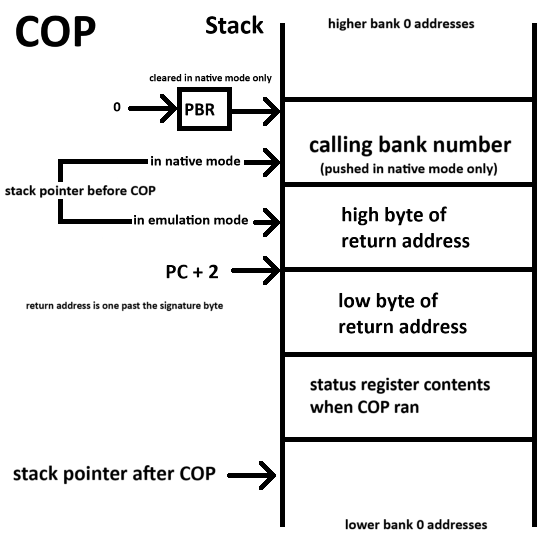We've just updated MediaWiki and its underlying software. If anything doesn't look or work quite right, please mention it to us. --RanAS
COP: Difference between revisions
From SnesLab
(→External Links: hid archive URL) |
(COP note) |
||
| (8 intermediate revisions by the same user not shown) | |||
| Line 35: | Line 35: | ||
|} | |} | ||
'''COP''' (Co-Processor) is a [[65c816]] instruction designed to run a co-processor command. The byte following the opcode is called the [[signature byte]] and is required by assemblers | '''COP''' (Co-Processor) is a [[65c816]] instruction designed to run a co-processor command. COP triggers a software interrupt and control is routed to the COP handler, whose address is stored in the COP vector at $00:FFE4 (in [[native mode]] anyway, in emulation mode $FFF4 is used instead). The byte following the opcode is called the [[signature byte]] and is required by assemblers: | ||
* Signature bytes of 00h to 7Fh can be programmer-defined | |||
* Signature bytes of 80h to FFh are reserved for future microprocessors by the [https://www.westerndesigncenter.com/ Western Design Center]<sup>[3]</sup> | |||
The state of the [[interrupt disable flag]] has no effect on the behavior of COP although it will be set after COP runs. | |||
Some examples of the kinds of microprocessors COP could be used to communicate with include: | |||
* floating point | |||
* graphics | |||
The [[PBR]] is cleared, but in native mode its previous value is pushed to the [[stack]]. | The [[PBR]] is cleared, but in native mode its previous value is pushed to the [[stack]]. | ||
| Line 46: | Line 52: | ||
</pre> | </pre> | ||
==== Cycle Skipped ==== | |||
* COP takes one fewer cycle in [[emulation mode]] as it doesn't need to push the [[program counter bank register]] to the [[stack]]. | * COP takes one fewer cycle in [[emulation mode]] as it doesn't need to push the [[program counter bank register]] to the [[stack]]. | ||
[[File:cop.png]] | |||
COP is not really used for anything on the SNES.<sup>[7]</sup> | |||
=== See Also === | === See Also === | ||
| Line 55: | Line 65: | ||
=== External Links === | === External Links === | ||
# [[Eyes & Lichty]], [https://archive.org/details/0893037893ProgrammingThe65816/page/447 page 447] on COP | |||
# [[Labiak]], [https://archive.org/details/Programming_the_65816/page/n145 page 135] on COP | |||
# section 7.15 of 65c816 datasheet | |||
# snes9x implementation of COP: https://github.com/snes9xgit/snes9x/blob/master/cpuops.cpp#L2738 | |||
# https://ersanio.gitbook.io/assembly-for-the-snes/deep-dives/misc | |||
# https://undisbeliever.net/snesdev/65816-opcodes.html#software-interrupts | |||
# https://forums.nesdev.org/viewtopic.php?p=176406#p176406 | |||
[[Category:ASM]] | [[Category:ASM]] | ||
Latest revision as of 03:52, 23 August 2024
| Basic Info | |||||||
|---|---|---|---|---|---|---|---|
| Addressing Mode | Opcode | Length | Speed | ||||
| Stack (Interrupt) | 02 | 2 bytes | 8 cycles* | ||||
| Flags Affected | ||||||||
|---|---|---|---|---|---|---|---|---|
| N | V | M | X | D | I | Z | C | |
| . | . | . | . | 0 | 1 | . | . | |
COP (Co-Processor) is a 65c816 instruction designed to run a co-processor command. COP triggers a software interrupt and control is routed to the COP handler, whose address is stored in the COP vector at $00:FFE4 (in native mode anyway, in emulation mode $FFF4 is used instead). The byte following the opcode is called the signature byte and is required by assemblers:
- Signature bytes of 00h to 7Fh can be programmer-defined
- Signature bytes of 80h to FFh are reserved for future microprocessors by the Western Design Center[3]
The state of the interrupt disable flag has no effect on the behavior of COP although it will be set after COP runs.
Some examples of the kinds of microprocessors COP could be used to communicate with include:
- floating point
- graphics
The PBR is cleared, but in native mode its previous value is pushed to the stack.
Syntax
COP sig
Cycle Skipped
- COP takes one fewer cycle in emulation mode as it doesn't need to push the program counter bank register to the stack.
COP is not really used for anything on the SNES.[7]
See Also
External Links
- Eyes & Lichty, page 447 on COP
- Labiak, page 135 on COP
- section 7.15 of 65c816 datasheet
- snes9x implementation of COP: https://github.com/snes9xgit/snes9x/blob/master/cpuops.cpp#L2738
- https://ersanio.gitbook.io/assembly-for-the-snes/deep-dives/misc
- https://undisbeliever.net/snesdev/65816-opcodes.html#software-interrupts
- https://forums.nesdev.org/viewtopic.php?p=176406#p176406


